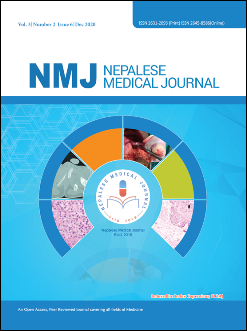Comparison of Intrathecal Midazolam and Fentanyl Added to Bupivacaine for Spinal Anesthesia in Patients Undergoing Appendicectomy
DOI:
https://doi.org/10.3126/nmj.v3i2.34398Keywords:
Appendicectomy, Bupivacaine, Fentanyl, MidazolamAbstract
Introduction: Hyperbaric Bupivacaine is the extensively used local anesthetic but the major disadvantage is profound sympathetic blockade leading to hypotension and prolonged duration of motor block. The addition of Fentanyl or Midazolam can provide excellent quality and prolong the duration of analgesia. The study aims to compare the effect of intrathecal Fentanyl with that of intrathecal Midazolam in combination with 0.5% hyperbaric Bupivacaine on the duration and quality of spinal anesthesia in patients undergoing appendicectomy.
Materials and Methods: This is a prospective, comparative and interventional study where patients were randomized into two equal groups. The study was conducted in a tertiary referral hospital from July 2018 to December 2018 after ethical approval. Group BF received Fentanyl and group BM received Midazolam The outcomes measured were, peak sensory level, quality of intraoperative analgesia and motor block, duration of effective analgesia, intraoperative and postoperative complications.
Results: A total of 44 patients were studied with 22 in each arm. The two groups were comparable in terms of age, weight, height, duration of surgery, and ASA status of the patients. Peak sensory level and degree of motor block were not statistically different in the two arms. Duration of effective analgesia was 293.16±35 min in the BF group and 267.80±32 min in the BM group (p=0.01). Increased incidence of pruritus was recorded during the postoperative period in the Fentanyl group.
Conclusions: Fentanyl and Midazolam both are equally effi cient adjuvant added to hyperbaric Bupivacaine for intrathecal use to improve the quality of spinal anesthesia in patients undergoing appendicectomy.
Downloads
Downloads
Published
How to Cite
Issue
Section
License
This license enables reusers to distribute, remix, adapt, and build upon the material in any medium or format, so long as attribution is given to the creator. The license allows for commercial use.
Copyright on any article published by Nepalese Medical Journal is retained by the author(s).
Authors grant Nepalese Medical Journal a license to publish the article and identify itself as the original publisher.
Authors also grant any third party the right to use the article freely as long as its integrity is maintained and its original authors, citation details and publisher are identified.




